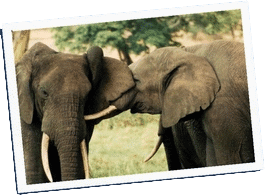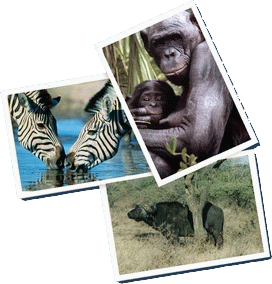|
|
Destinations - Southern Circuits
|
| |
|
| |
Mikumi to the north of the Selous lies only 300 kms away from Dar es Salaam. The Park, established to protect the environment and the resident animals, is also an important educational center for students of ecology and conservation. The Mikumi flood plain is the main feature of the Park along with the bordering mountain ranges. Animals commonly found here include lion, Elands, Hartebeests, Buffaloes, Wildebeests, Giraffes, Zebras, Hippos and Elephants. Over 300 species of birds have been observed in the park, many of which are Eurasian migrants who stay between October and April.
|
|
| |
Tanzania is home to one of single largest remaining elephant populations in the world. Most of these elephants are found in the remote and wildly beautiful Selous Game Reserve, covering an area of 55,000 sq. kms, larger than Switzerland. Only in the Serengeti will visitors see a greater concentration of wildlife. Yet Selous boasts
|
 |
Tanzania's largest population of large numbers of buffalo, hippo and wild dog including other species commonly seen are lion, bushbuck, impala, giraffe, eland, baboon, zebra and greater kudu.
Walking safaris, game drives and boat trips are organized. The best time to visit is during the dry season, when game is forced from hiding places to the river to drink. |
|
| |
Udzungwa Mountains National Park is a recently established conservation area of about 2,000 sq. km in the Iringa and Morogoro regions of south – central Tanzania. The Great Ruaha River to the north and the Mikumi – Ifakara road to the east, border the park. The major attraction of the park is it bio-diversity and unique rainforest, where many rare plants, not found anywhere else in the world, have been identified, from a tiny African violet to 30 meter high trees.
As well as being home to about six types of primates, including two endemic species the Iringa red colobus monkey and the Sanje crested mangabey.
|
|
| |
Katavi National Park, one on the upcoming tourist attractions in Tanzania is located southward close to the shores of Lake Tanganyika (longest freshwater lake in the world – (677kms) second deepest (1,443m). Gazetted in 1974 as a National Park, Katavi covers a total land area of 2,253 kilometers, and the closest town is Mpanda Town, some 40 kilometers away. It is a remote, unspoiled beautiful wild park with unique attractions ranging from Lake Katavi, different wildlife species and the scenery. Katavi National Park boasts to be among the most natural wildlife sanctuaries in Africa, where human interference to nature is minimal. Located in Rukwa region, Katavi National Park is abundant in wildlife species, including the big mammals and plants. Crocodiles and Hippos are seen basking on the banks of the Katuma River, which connects Lake Katavi and Lake Chada. Lake Chada is particularly rich in wildlife and also in its concentration of crocodiles. Miombo woodlands with scattered acacia trees comprise the main vegetation of the park. Other Attraction in the park includes walking, driving and camping safaris.
|
|
| |
A mountainous strip that borders the shores of Lake Tanganyika, about 16km from Kigoma. Tanzania's smallest park covers only 52 sq. km. It can only be reached by boat from Kigoma. Gombe Stream offers visitors the rare chance to observe the chimpanzee communities made famous by British explorer Jane Goodall. A number of monkey species can also be seen including red colobus, red-tail and blue monkeys. The area is heavily forested making it an unsuitable habitat for carnivores and safe for walking safaris. Bird watchers will be richly rewarded.
|
|
Rubondo Island National Park |
Floating In Africa's Largest Lake: RUBONDO National Park is an island of wildlife, covering about 240 square kilometers. This is another place where visitors can combine a national park safari with a beach holiday.
The park provides a variety of habitats ranging from Savannah to open woodland, dense forest, papyrus swamps and sandy beaches. There are also a wide variety of animals including bushbuck, crocodile, elephant, gent, giraffe, hippo mongoose vervet monkey and the reclusive statunga – a shaggy aquatic antelope. The bird – life is unique with birds from east, central and southern Africa flocking to ‘ Bird Island' to breed. Bee – eaters, fish eagle, ibis, kingfisher and saddle – billed stork will be seen while tilapia and Nile perch abound in the lake.
|
|
|
Nyerere Cultural Centre (Nyumba ya Sanaa), Ohio Street, adjacent to Royal Palm Hotel, P.O. Box 8701, Dar es Salaam, Tanzania, Tel.: +255-22-2137456 Fax: +255-22-2137456, Mobile:+255 (0) 745-872726 and +255 (0) 744-464955, Email info@planetsafaris.com ; planetsafari@linktz.com |
| |
|
| |
|
| |
The Ruaha National Park covering an area of 10,300 is the country's biggest elephant sanctuary. Its name derives from the Great Ruaha River, which flows along its eastern border, creating spectacular gorges. Flowing into the Rufiji /river, the Great Ruaha is home to hippo and crocodile. Waterbuck, reedbuck and buffalo venture to the river's edge to drink, attracting the attention of lion, leopard, hyena, wild dog and jackal.
Various antelope species, such as greater and lesser kudu, impala, sable and roan antelope, Grant's gazelle and the tiny dik-dik thrive in the grasslands bordering the river alongside giraffe, zebra, warthog, mongoose, porcupine, wild cat and civet.
Birdlife is prolific, over 370 species have been recorded, and some of which are not found in northern Tanzania. Eurasian migrants flock to Ruaha twice a year – March to April and October to November – joining the resident kingfishers, hornbills, sunbirds, egrets and plovers.
Best months for game viewing are during the dry season from May to December, when the animals are concentrated around the shrinking water sources. The park has an airstrip for light aircraft on the western bank of the river.
|
|

|
Mahale Mountains National Park |
The other sanctuary of the chimpanzee, Mahale Mountains National Park, is also reached by boat from Kigoma. Covering an area of approximately 1,000 sq. Km, the park's western boundary is the shore of Lake Tanganyika. The chimpanzee population is estimated at around 1,000 and they may be observed in their natural habitat in-groups of up to 30. Boboons and colobus monkeys also live in the park while other animals found there include buffalo, bush pig, elephant, giraffe, leopard, lion, porcupine and various types of antelope. Lake Tanganyika is home to more than 250 different species of fish.
|
|
|
| |
|
|